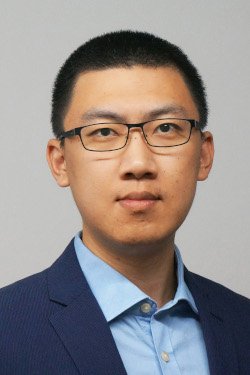Xiaolong Liu
2022 Regional Award Winner — Post-Doc

Current Position:
Assistant Professor of Physics
Institution:
University of Notre Dame (previously, Cornell University)
Discipline:
Condensed Matter Physics

Current Position:
Assistant Professor of Physics
Institution:
University of Notre Dame (previously, Cornell University)
Discipline:
Condensed Matter Physics
Recognized for: Development of new types of microscopic imaging techniques, like the high-speed scanned Josephson-tunneling microscopy technique (SJTM), that explore vexing problems in quantum physics. The new microscope Xiaolong Liu, PhD, developed led to the very first atomic-scale observation of Cooper-pair density waves—standing waves of electron pairs in a superconductor, similar to the standing wave of a plucked string. Liu also engaged in another exciting area of physics—electron superfluids, an electronic version of a fluid, much like water, but experiences no resistance to flow. Using SJTM, Liu showed that jet-speeds of up to 3,000 meters per second (up to MACH 9) can be reached by electron pairs in a superfluid. The new imaging methodologies being developed by Liu are equipping scientists with novel tools to explore exciting new problems in quantum physics.
Areas of Research Interest and Expertise: Superconductivity, Topological Materials, 2D Materials, Scanning Probe Microscopy, Atom Manipulation
Previous Positions:
BS, University of Science and Technology of China
PhD, Northwestern University (Adviser: Mark C. Hersam)
Kavli Postdoctoral Fellow, Cornell University (Advisor: J. C. Séamus Davis)
Research Summary:
Xiaolong Liu, PhD, is a low-temperature experimentalist and quantum microscopist working in the field of condensed matter physics. He has developed new types of microscopic imaging techniques that explore exotic and theoretically challenging problems in quantum physics. Liu’s new quantum microscope—the high-speed scanned Josephson-tunneling microscopy technique (SJTM)—has achieved record-breaking resolution in visualizations of superconductors and led to the very first atomic-scale observation of a unique quantum state found in superconductors, known as Cooper-pair density waves—standing waves of electron pairs found in a superconductor, similar to the standing wave of a plucked string, predicted decades before but previously never experimentally observed in the class of materials known as transition metal dichalcogenides.
Liu also adapted the SJTM technique to engage in another exciting area of physics—electron superfluids, an electronic version of a fluid, much like water, but experiences no resistance to flow. With this technique, Liu successfully produced atomic-scale visualizations of flowing superfluids in a magnetic field. The microscope revealed that electron pairs in a superfluid can reach jet-speeds of up to 3,000 meters per second, well past the speed of sound (up to MACH 9). With this new experimental platform, scientists will now have the capacity to visualize properties of electron fluids at the atomic scale in numerous quantum materials, like topological superconductors and ultra-metals.
Liu’s widely-applicable new imaging methodologies have equipped scientists with the key tools they will need to explore new and fascinating problems in quantum physics. These achievements of Liu are made possible by the continued funding support from the Gordon and Betty Moore Foundation through the EPiQS initiative, which allowed unprecedented research initiatives and stimulated inventions of unique new instruments — all at the specialized facilities provided by Cornell and within the Kavli Institute at Cornell.
Four centuries ago, a new visible world was discovered with the help of optical microscopes. I aim to reveal a new quantum world with atomistic details by the invention and application of quantum microscopes.
Key Publications:
Other Honors:
| 2022 | Early Career Scientist Prize in Low Temperature Physics, IUPAP |
| 2020 | Nanotechnology Young Researcher Award, IOP |
| 2019 | Wayne B. Nottingham Prize, PEC |
| 2019 | Kavli Postdoctoral Fellowship, Cornell University |
| 2018 | Graduate Student Award, MRS |
| 2018 | Cabell Fellowship, Northwestern University |
| 2017 | Dorothy M. and Earl S. Hoffman Award, AVS |
| 2017 | Nanometer-Scale Science and Technology Division Student Award, AVS |
| 2017 | Iris M. Ovshinsky Travel Grant Award, APS |
| 2016 | Ryan Fellowship, Northwestern University |
In the Media:
Phys.org – Electron-pair discovery advances field of quantum materials
Nature – How to grow a long-sought wonder material: on a silver platter